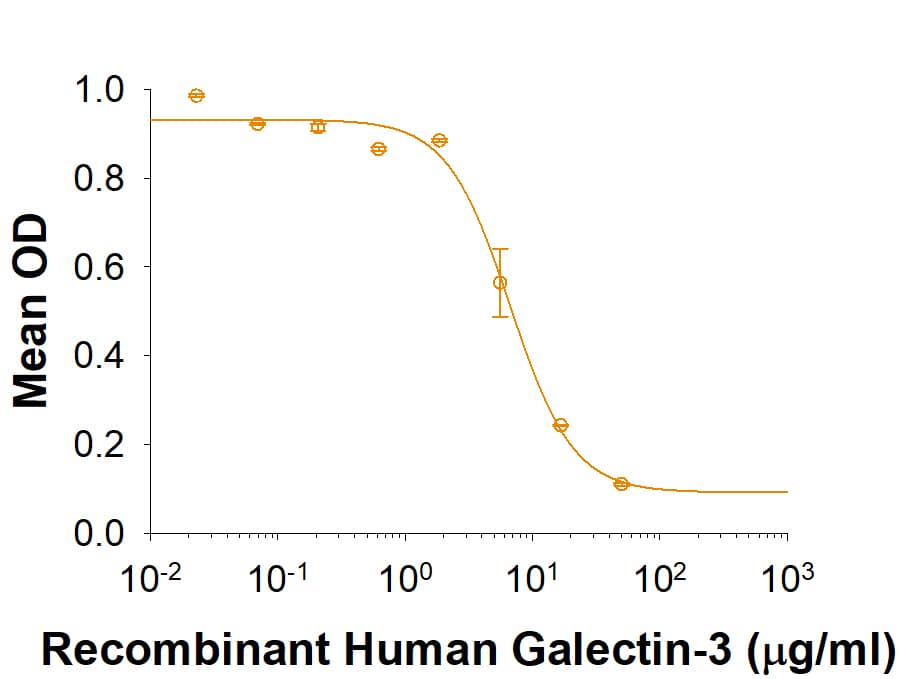Recombinant Human Galectin-3 Protein
R&D Systems, part of Bio-Techne | Catalog # 1154-GA

Key Product Details
Product Specifications
Source
Ala2-Ile250
Purity
Endotoxin Level
N-terminal Sequence Analysis
Predicted Molecular Mass
Activity
The ED50 for this effect is 3-10 µg/mL.
Reviewed Applications
Read 1 review rated 1 using 1154-GA in the following applications:
Scientific Data Images for Recombinant Human Galectin-3 Protein
Recombinant Human Galectin-3 Protein Bioactivity
Recombinant Human Galectin-3 (Catalog # 1154-GA) agglutinates human red blood cells. The ED50 for this effect is 3-10 µg/mL.Formulation, Preparation and Storage
Carrier Free
What does CF mean?CF stands for Carrier Free (CF). We typically add Bovine Serum Albumin (BSA) as a carrier protein to our recombinant proteins. Adding a carrier protein enhances protein stability, increases shelf-life, and allows the recombinant protein to be stored at a more dilute concentration. The carrier free version does not contain BSA.
What formulation is right for me?In general, we advise purchasing the recombinant protein with BSA for use in cell or tissue culture, or as an ELISA standard. In contrast, the carrier free protein is recommended for applications, in which the presence of BSA could interfere.
Carrier: 1154-GA
| Formulation | Lyophilized from a 0.2 μm filtered solution in PBS and Betamercaptoethanol with BSA as a carrier protein. |
| Reconstitution | Reconstitute at 50 μg/mL in sterile PBS containing at least 0.1% human or bovine serum albumin. |
| Shipping | The product is shipped with polar packs. Upon receipt, store it immediately at the temperature recommended below. |
| Stability & Storage | Use a manual defrost freezer and avoid repeated freeze-thaw cycles.
|
Carrier Free: 1154-GA/CF
| Formulation | Lyophilized from a 0.2 μm filtered solution in PBS and Betamercaptoethanol. |
| Reconstitution | Reconstitute at 100 μg/mL in sterile PBS. |
| Shipping | The product is shipped with polar packs. Upon receipt, store it immediately at the temperature recommended below. |
| Stability & Storage | Use a manual defrost freezer and avoid repeated freeze-thaw cycles.
|
Background: Galectin-3
Human Galectin-3, also known as Mac-2, L29, CBP35, and epsilonBP, is classified as a chimeric member of the Galectin superfamily and contains one carbohydrate recognition domain (CRD) linked to a nonlectin domain (1, 2). Mature human Galectin-3 shares 78% and 79% amino acid (aa) sequence identity with mouse and rat Galectin-3, respectively. Human Galectin-3 is a 26 kDa protein that can be nuclear, cytoplasmic, or secreted (3, 4). Nuclear Galectin-3 can modulate gene expression, while cytosolic Galectin-3 can inhibit apoptosis and can participate in exocytosis, Caveolin-mediated endocytosis, and macrophage-mediated clearance of apoptotic cells (5-7). Extracellular Galectin-3 has been shown to form high-order oligomers that promote the crosslinking of cell surface oligosacchraides as well as integrin-dependent cell adhesion and apoptosis (8-11). Galectin-3 contributes to the innate immune response against Candida albicans and Streptococcus pneumoniae, and it can facilitate acute inflammatory responses via neutrophil activation and opsonization, macrophage recruitment, and mast cell activation (12-14). Galectin-3 can also contribute to chronic inflammation and fibrosis (15). It is implicated in neuroinflammatory disorders of the central nervous system, cardiac fibrosis, and heart failure, as well as tumor growth, progression, and metastasis (16-18).
References
- Robertson, M.W. et al. (1990) Biochemistry 29:8093.
- Elola, M.T. et al. (2007) Cell. Mol. Life Sci. 64:1679.
- Haudek, K.C. et al. (2010) Biochim. Biophys. Acta 1800:181.
- Hughes, R.C. (1999) Biochim. Biophys. Acta 1473:172.
- Krzeslak, A. and A. Lipinska (2004) Cell. Mol. Biol. Lett. 9:305.
- Dumic, J. et al. (2006) Biochim. Biophys. Acta 1760:616.
- Sano, H. et al. (2003) J. Clin. Invest. 112:389.
- Ahmad, N. et al. (2004) J. Biol. Chem. 279:10841.
- Friedrichs, J. et al. (2008) J. Biol. Chem. 283:32264.
- Wen, Y. et al. (2006) J. Cell. Biochem. 98:115.
- Zhuo, Y. et al. (2008) J. Biol. Chem. 283:22177.
- Henderson, N.C. and T. Sethi (2009) Immunol. Rev. 230:160.
- Kohatsu, L. et al. (2006) J. Immunol. 177:4718.
- Nieminen, J. et al. (2008) J. Immunol. 180:2466.
- Henderson, N.C. et al. (2008) Am. J. Pathol. 172:288.
- Newlaczyl, A.U. and L.G. Yu (2011) Cancer Lett. 313:123.
- Sherwi, N. et al. (2012) Future Cardiol. 8:885.
- Shin, T. (2013) Acta Histochem. 115:407.
Alternate Names
Gene Symbol
UniProt
Additional Galectin-3 Products
Product Documents for Recombinant Human Galectin-3 Protein
Product Specific Notices for Recombinant Human Galectin-3 Protein
For research use only
